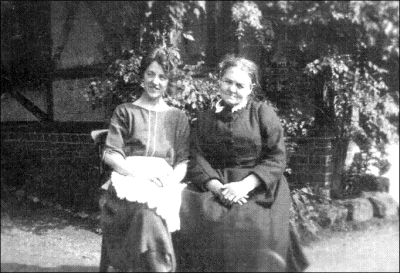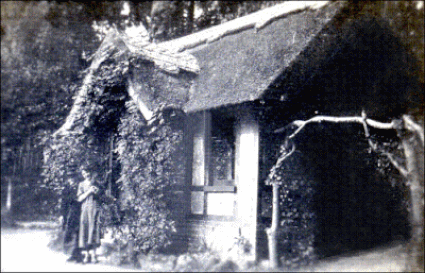Fatal gun accident in Brundall
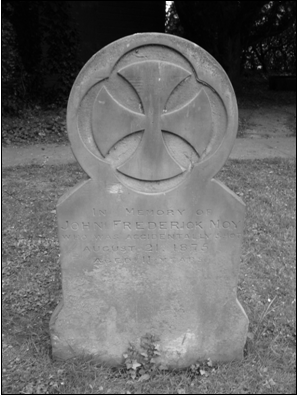 The gravestone in Brundall churchyard reads: In Memory of John Frederick Moy who was accidentally shot, August 21 1875, aged 11 years
The gravestone in Brundall churchyard reads: In Memory of John Frederick Moy who was accidentally shot, August 21 1875, aged 11 years
‘In Memory of John Frederick Moy who was accidentally shot, August 21 1875, aged 11 years’ is the intriguing wording on a small grave in Brundall Churchyard. In the EDP of August 24th 1875 there is a report of the inquest into this very sad event.
On the previous Saturday afternoon John Moy, who lived in Plumstead Road, Witton, was in the back kitchen of the cottage of his friend, George Glasspoole, aged 13, in Brundall. George’s father was in Norwich and his mother was out gleaning when he ‘got a gun down from the bedroom, loaded it with powder and shot, and put a cap on.’ He intended to go and shoot in the back garden but John asked to have a shot and proceeded to take hold of the gun by the end of the barrel. George ‘at the time had the cock partly pulled up with his thumb upon it’. When John got hold of the gun the cock slipped off George’s thumb and shot John dead.
George had no intention of harming his friend and had told him to leave go of the gun. When he saw what had happened he understandably panicked and ran to the house of Mrs Jane Dingle of Braydeston, the wife of the landlord of The White Horse. (Then, the White Horse was the thatched building in the centre of the village which is now a restaurant. A provisional order was made on 3rd September 1877 for the licence to be transferred to new premises to be erected near Station Lane and this happened in 1880.)
George told Mrs Dingle that an old man had come in and shot his friend. ‘He afterward contradicted his statement saying it was no use telling stories.’ John’s father, William, said that the boys were the best of friends, never used to quarrel, were nearly always together, and were like brothers.
The gun had been lent to George’s father, John Glasspoole by a neighbour, John Harper (landlord of The Ram at the time), to frighten birds away with. The jury returned a verdict of ‘Accidentally shot’.
According to the census for 1871 John Glasspoole, a market gardener, lived with his wife Harriet, sons Obadiah, Ebenezer, Robert, and Herbert who were all agricultural labourers or gardeners and Henry and George and daughter Frances who were ‘scholars’. By 1881 there were just John and Harriet with Herbert and George who were now agricultural labourers living at no. 8 The Street. The position of the house in relation to other buildings suggests that it could well have been opposite what was then The White Horse. Research into ‘Inglebank’ for the book ‘Houses of Brundall and Braydeston’ connects the Glasspoole family to the land there so even if they didn’t actually live in what is now Inglebank they could well have lived in a cottage nearby.
On the previous Saturday afternoon John Moy, who lived in Plumstead Road, Witton, was in the back kitchen of the cottage of his friend, George Glasspoole, aged 13, in Brundall. George’s father was in Norwich and his mother was out gleaning when he ‘got a gun down from the bedroom, loaded it with powder and shot, and put a cap on.’ He intended to go and shoot in the back garden but John asked to have a shot and proceeded to take hold of the gun by the end of the barrel. George ‘at the time had the cock partly pulled up with his thumb upon it’. When John got hold of the gun the cock slipped off George’s thumb and shot John dead.
George had no intention of harming his friend and had told him to leave go of the gun. When he saw what had happened he understandably panicked and ran to the house of Mrs Jane Dingle of Braydeston, the wife of the landlord of The White Horse. (Then, the White Horse was the thatched building in the centre of the village which is now a restaurant. A provisional order was made on 3rd September 1877 for the licence to be transferred to new premises to be erected near Station Lane and this happened in 1880.)
George told Mrs Dingle that an old man had come in and shot his friend. ‘He afterward contradicted his statement saying it was no use telling stories.’ John’s father, William, said that the boys were the best of friends, never used to quarrel, were nearly always together, and were like brothers.
The gun had been lent to George’s father, John Glasspoole by a neighbour, John Harper (landlord of The Ram at the time), to frighten birds away with. The jury returned a verdict of ‘Accidentally shot’.
According to the census for 1871 John Glasspoole, a market gardener, lived with his wife Harriet, sons Obadiah, Ebenezer, Robert, and Herbert who were all agricultural labourers or gardeners and Henry and George and daughter Frances who were ‘scholars’. By 1881 there were just John and Harriet with Herbert and George who were now agricultural labourers living at no. 8 The Street. The position of the house in relation to other buildings suggests that it could well have been opposite what was then The White Horse. Research into ‘Inglebank’ for the book ‘Houses of Brundall and Braydeston’ connects the Glasspoole family to the land there so even if they didn’t actually live in what is now Inglebank they could well have lived in a cottage nearby.
A Brundall wedding captured on film
On a blustery November afternoon in 1949, guests arrive at the Roman Catholic Chapel of St George in Fishergate, Norwich, to attend the wedding of Mr Henry Woods aged 31 and Miss Remina Valori aged 27. Departing from the bride’s home in Catton Grove Road, the bridal party arrives at the chapel in a pair of Rolls Royce cars, followed by the bride, dressed in traditional white. However, it is not Guido, the bride’s father, escorting Remina down the aisle but probably her elder brother Frank, aged about 38 years old and acting as head of the family in Guido’s absence. (Guido’s death in Italy was registered in Norwich, just four years later in 1953.)
Brief glimpses of the inside of the chapel show the ceremony under way, before the newlyweds emerge smiling and posing for photographs. The bridal party departs in the Rolls Royce cars with the guests following in a pair of coaches, all headed for the reception venue: the White Horse in Brundall.
In the Pavilion the bridal party and guests sit down to a formal dinner followed by the cake cutting, a toast, speeches and telegrams and an ice cream dessert. No doubt the ice cream had been supplied by family members and is enthusiastically served out by Frank Valori.
With the formalities out of the way, the party begins as guests dance, drink tea, chat and sign the bridal book. A succession of guests sing songs, accompanied by a piano, followed by a group dance. No doubt this would have delighted Remina’s mother and her side of the family who were musical entertainers.
The evening ends with another toast to the happy couple, as two young girls sing 'For He's a Jolly Good Fellow' and the guests begin to leave. The film concludes with the newlyweds surveying their wedding presents.
This film gives us an insight into a family wedding at a time of austerity when rationing was still in place after the end of WW2. The Valori family, who knew all about the catering business, must have chosen The White Horse because of its good food, hospitality and reputation. After all, they considered it worthwhile to hire cars and two coaches to transport their guests seven miles out of the City and back again.
To search or browse over 200 hours of footage of our regional heritage free visit www.eafa.org.uk
To go directly to the wedding film page, click here
Brief glimpses of the inside of the chapel show the ceremony under way, before the newlyweds emerge smiling and posing for photographs. The bridal party departs in the Rolls Royce cars with the guests following in a pair of coaches, all headed for the reception venue: the White Horse in Brundall.
In the Pavilion the bridal party and guests sit down to a formal dinner followed by the cake cutting, a toast, speeches and telegrams and an ice cream dessert. No doubt the ice cream had been supplied by family members and is enthusiastically served out by Frank Valori.
With the formalities out of the way, the party begins as guests dance, drink tea, chat and sign the bridal book. A succession of guests sing songs, accompanied by a piano, followed by a group dance. No doubt this would have delighted Remina’s mother and her side of the family who were musical entertainers.
The evening ends with another toast to the happy couple, as two young girls sing 'For He's a Jolly Good Fellow' and the guests begin to leave. The film concludes with the newlyweds surveying their wedding presents.
This film gives us an insight into a family wedding at a time of austerity when rationing was still in place after the end of WW2. The Valori family, who knew all about the catering business, must have chosen The White Horse because of its good food, hospitality and reputation. After all, they considered it worthwhile to hire cars and two coaches to transport their guests seven miles out of the City and back again.
To search or browse over 200 hours of footage of our regional heritage free visit www.eafa.org.uk
To go directly to the wedding film page, click here
The headgear named after Brundall
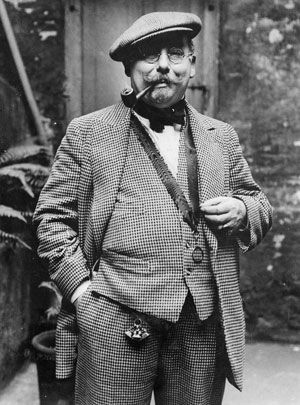 Rumsey Wells, who created the Brundall cap
Rumsey Wells, who created the Brundall cap
‘The Brundall’ is a cap by the once well known hat maker, Rumsey Wells. Some may remember the shop in St Andrews Street, Norwich which closed in 1974. Rumsey had died in 1937, aged 60, and with no fifth generation to take over the business started by his great grandfather 200 years ago, two members of staff, Edna Watling and Elsie Bugden, ran it until 1974 when they found it difficult to find craftsmen to make the caps. They refused to go for mass production.
Rumsey claimed that he made the most expensive caps in the world. He invented the ‘Doggie’ which was made individually to fit and cost a guinea. Others cost as much as £2. He had customers all over the Empire and his hats would be recognised. They were made of ‘the nicest English, Scotch and Irish tweeds’.
He was proud of the fact that they were made in ‘the capital of the King’s County, Norfolk’ and he gave his caps local names such as the Blofield, the Brancaster, the Brundall and the Reepham.
He even found some experienced silk weavers and with them produced finely woven and beautiful silks in traditional patterns. His efforts to revive the Norwich silk industry received royal recognition.
His caps may have been for the elite and he sported an elegant beard, wore immaculate shirts and ties, a cloak, and of course a hat, but he travelled round Norwich on a bicycle and supported local charities and cycling organisations. The shop is no longer there but the Rumsey Wells public house stands on the spot where his shop was and there is a blue plaque beside the entrance to Rumsey Wells Place, St Andrews Street.
Rumsey claimed that he made the most expensive caps in the world. He invented the ‘Doggie’ which was made individually to fit and cost a guinea. Others cost as much as £2. He had customers all over the Empire and his hats would be recognised. They were made of ‘the nicest English, Scotch and Irish tweeds’.
He was proud of the fact that they were made in ‘the capital of the King’s County, Norfolk’ and he gave his caps local names such as the Blofield, the Brancaster, the Brundall and the Reepham.
He even found some experienced silk weavers and with them produced finely woven and beautiful silks in traditional patterns. His efforts to revive the Norwich silk industry received royal recognition.
His caps may have been for the elite and he sported an elegant beard, wore immaculate shirts and ties, a cloak, and of course a hat, but he travelled round Norwich on a bicycle and supported local charities and cycling organisations. The shop is no longer there but the Rumsey Wells public house stands on the spot where his shop was and there is a blue plaque beside the entrance to Rumsey Wells Place, St Andrews Street.
A glimpse of past family life
An enquiry led me to revisit a story that had been told to me when we were preparing ‘The Book of Brundall’, writes Barbara Ayers. The rather charming photographs were taken on Monday September 14th 1925 by William Watson Tripp, father of John Tripp, the source of my information. William was an artist, printer, and Methodist lay preacher, who, in the 1960s lived in Stafford Road, Great Yarmouth.
Our story is about Eva, his sister, John’s aunt. The photographs were taken in Brundall Gardens where Eva worked as a ‘domestic’ at Redclyffe House. The elderly lady is Mrs Wright who lived in a residential home in Yarmouth. They had brought her to Brundall Gardens for the day as a treat. Eva posed outside the little cottage, which was actually the pottery museum, pretending that it was her home. At the time, of course, she would not have been able to aspire to having her own house. ‘The Book of Brundall’ tells us that ‘The cottages, dotted about, which formerly housed marshmen, were used as summerhouses and picnic places and one was converted into a museum to display the pottery dug from the gardens’. There is also a picture of Eva with a family friend and her sister-in-law, Dorothy Tripp,
Going into service wasn’t Eva’s first choice of job or even her first employment. John told me that she had wanted to be a nurse but the doctor who inteviewed her said she had to undress and have a medical examination and she wasn’t having that! Then she worked as a seamstress making mourning clothes in black silk but didn’t get on very well because of course black is a very difficult colour to work with.
On August 6th 1925 Eva had married Henry Charles Dennington, the gardener’s son. This was against Henry’s father’s wishes as he had a girl with money lined up for him! Eva, and Henry, an aircraft engineer, moved to Wolverhampton when the aircraft manufacturer Boulton & Paul transferred there. After the war he left the aircraft business fearing that work would cease and became a gardener at Whitwick Manor in Tettenhall Wood, Wolverhampton. Eva and Henry were deeply religious, Eva being a lay preacher at many of the small chapels in the Black Country and Henry involved with the congregational chapel in Tettenhall Wood. Eva and Henry had three children, Bernard, David and June. It is June’s son, Jeremy Marple, who contacted the BLHG website and gave us some of this information about his grandmother, Eva.
Our story is about Eva, his sister, John’s aunt. The photographs were taken in Brundall Gardens where Eva worked as a ‘domestic’ at Redclyffe House. The elderly lady is Mrs Wright who lived in a residential home in Yarmouth. They had brought her to Brundall Gardens for the day as a treat. Eva posed outside the little cottage, which was actually the pottery museum, pretending that it was her home. At the time, of course, she would not have been able to aspire to having her own house. ‘The Book of Brundall’ tells us that ‘The cottages, dotted about, which formerly housed marshmen, were used as summerhouses and picnic places and one was converted into a museum to display the pottery dug from the gardens’. There is also a picture of Eva with a family friend and her sister-in-law, Dorothy Tripp,
Going into service wasn’t Eva’s first choice of job or even her first employment. John told me that she had wanted to be a nurse but the doctor who inteviewed her said she had to undress and have a medical examination and she wasn’t having that! Then she worked as a seamstress making mourning clothes in black silk but didn’t get on very well because of course black is a very difficult colour to work with.
On August 6th 1925 Eva had married Henry Charles Dennington, the gardener’s son. This was against Henry’s father’s wishes as he had a girl with money lined up for him! Eva, and Henry, an aircraft engineer, moved to Wolverhampton when the aircraft manufacturer Boulton & Paul transferred there. After the war he left the aircraft business fearing that work would cease and became a gardener at Whitwick Manor in Tettenhall Wood, Wolverhampton. Eva and Henry were deeply religious, Eva being a lay preacher at many of the small chapels in the Black Country and Henry involved with the congregational chapel in Tettenhall Wood. Eva and Henry had three children, Bernard, David and June. It is June’s son, Jeremy Marple, who contacted the BLHG website and gave us some of this information about his grandmother, Eva.
Can you solve the mystery of the plaque?
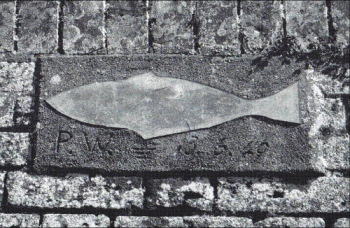 On the Finch Way estate in The Street, is a plaque with a fish on it.
On the Finch Way estate in The Street, is a plaque with a fish on it.
On the Finch Way estate in The Street, part of the wall of what was Brundall House (pulled down in 1969) still remains.
This plaque with the outline of a fish is to be found on it. Can anyone discover what it is?
There are the initials P.W. inscribed plus a date.
In the First World War Brundall House was an auxiliary war hospital - to see photos of the soldiers and Brundall House, click here
This plaque with the outline of a fish is to be found on it. Can anyone discover what it is?
There are the initials P.W. inscribed plus a date.
In the First World War Brundall House was an auxiliary war hospital - to see photos of the soldiers and Brundall House, click here
Alan Hunter, author of the George Gently detective stories
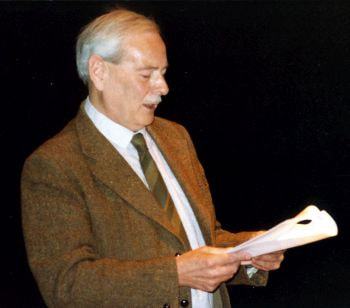
Many people will have seen Alan Hunter walking around Brundall, possibly puffing on his pipe, but few will have realised who this unassuming man was, and fewer still would have known him.
From 1974 until his death in 2005, he lived in St Laurence Avenue with wife, Adelaide, and daughter, Helen. He was, in fact, the author of the George Gently novels, writing 48 books about the detective over 40 years.
Unfortunately he didn't live to see his creations on television. Gently is played by a Norfolk actor, Martin Shaw, but the location has been moved to the North East whereas Norfolk was very much the inspiration for much of Alan’s work.
He was born in Hoveton St John and had five older sisters. His father was a poultry farmer and his uncle, Percy Hunter, a Ludham boatbuilder. After helping in the family business when he left school, Alan volunteered for the Air Force at the outbreak of the war.
He married Adelaide in 1944 and they lived with her parents at The Shrubbery in Strumpshaw Road until they moved to ‘Fairwinds’, a bungalow two doors from the Ram.
They were to own bookshops in both Norwich and Cromer before finally settling in Brundall again.
From 1974 until his death in 2005, he lived in St Laurence Avenue with wife, Adelaide, and daughter, Helen. He was, in fact, the author of the George Gently novels, writing 48 books about the detective over 40 years.
Unfortunately he didn't live to see his creations on television. Gently is played by a Norfolk actor, Martin Shaw, but the location has been moved to the North East whereas Norfolk was very much the inspiration for much of Alan’s work.
He was born in Hoveton St John and had five older sisters. His father was a poultry farmer and his uncle, Percy Hunter, a Ludham boatbuilder. After helping in the family business when he left school, Alan volunteered for the Air Force at the outbreak of the war.
He married Adelaide in 1944 and they lived with her parents at The Shrubbery in Strumpshaw Road until they moved to ‘Fairwinds’, a bungalow two doors from the Ram.
They were to own bookshops in both Norwich and Cromer before finally settling in Brundall again.
Medical matters
Brundall may have a busy health centre now but there was a time when the village didn’t even have its own GP. It was served by Blofield doctor, Robert McKelvie, and then his son Dr John McKelvie. The Blofield practice held surgeries in Dr Robert McKelvie’s house (St Ninians), an outbuilding at ‘Uplands’, and Links Avenue, at various times until the 1960s.
It was in 1924 that the medical practice, which was based in Acle, decided that Brundall needed its own doctor and 'Bradesfield', a house in Blofield Road was built. In the 1960s the workload started to become too great for the one doctor, Dr Ian Gray, and he was joined by Dr David Varvel in 1969. The Health Centre in The Dales opened in 1980 and by the time Dr Gray retired in 1985 there were three more doctors working there, Drs Rigby, Harston and Ashman.
It was in 1924 that the medical practice, which was based in Acle, decided that Brundall needed its own doctor and 'Bradesfield', a house in Blofield Road was built. In the 1960s the workload started to become too great for the one doctor, Dr Ian Gray, and he was joined by Dr David Varvel in 1969. The Health Centre in The Dales opened in 1980 and by the time Dr Gray retired in 1985 there were three more doctors working there, Drs Rigby, Harston and Ashman.
Dr Joyce Lambert and the story of the Broads
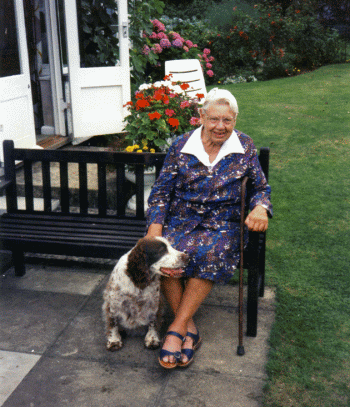 Dr Joyce Lambert
Dr Joyce Lambert
Although born in London in 1916, Dr Joyce Lambert, botanist and ecologist, was brought up in Brundall, staying at her grandparents’ house in West End Avenue.
She went to Norwich High School for girls, studied botany at the University of Wales, and later took a doctorate at London University. In 1961 she was appointed lecturer in botany at Southampton University.
In the 1950s, supported by Cambridge University, she confirmed by stratigraphic sampling that the Broads were man made, the result of peat diggings. Some of her investigative borings took place at Surlingham Broad. Her theory was at first greeted with scepticism.
In 1979 she returned to live at the bungalow, ‘Toft Monks’, in Brundall, which her grandfather had built. She never married. She was a lively personality, short and broad of stature, whose mental faculties were sharp to the end. She was also a keen supporter of Norwich City!
She went to Norwich High School for girls, studied botany at the University of Wales, and later took a doctorate at London University. In 1961 she was appointed lecturer in botany at Southampton University.
In the 1950s, supported by Cambridge University, she confirmed by stratigraphic sampling that the Broads were man made, the result of peat diggings. Some of her investigative borings took place at Surlingham Broad. Her theory was at first greeted with scepticism.
In 1979 she returned to live at the bungalow, ‘Toft Monks’, in Brundall, which her grandfather had built. She never married. She was a lively personality, short and broad of stature, whose mental faculties were sharp to the end. She was also a keen supporter of Norwich City!
Copyright: Nothing on this website may be copied or published without the permission of the Brundall Local History Group. This does not mean we will not give permission, but you do have to ask us. The archive material has come from many sources and there are many copyright holders.

